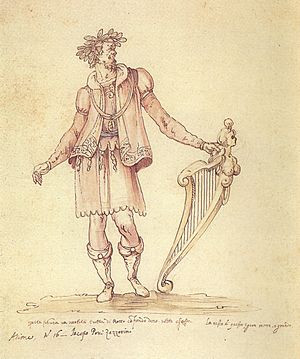Jacopo Peri facts for kids
Quick facts for kids
Jacopo Peri
|
|
|---|---|

Jacopo Peri
|
|
| Born | 20 August 1561 Rome, Papal States
|
| Died | 12 August 1633 (aged 71) Florence, Grand Duchy of Tuscany
|
| Occupation | Italian composer and singer |
Jacopo Peri (born August 20, 1561 – died August 12, 1633) was an Italian composer and singer. He was active during a time when music was changing from the Renaissance style to the Baroque style. Many people call him the inventor of opera.
Peri wrote Dafne (around 1597), which is considered the first work to be called an opera. He also wrote Euridice (1600), which is the oldest opera that still exists today.
Contents
Jacopo Peri's Life Story
Peri was born in either Rome or Florence, Italy. His family was middle-class. He worked as a singer at a church in Florence called SS. Annunziati. This church was very important and connected to the powerful Medici family.
Because he was talented, Peri studied music in Florence with a teacher named Cristofano Malvezzi. He then worked in several churches as an organ player and a singer. Around 1588, he started working for the Medici court. He began as a tenor singer and keyboard player, and later became a composer. His early works included music for plays, short musical performances called intermedi, and songs called madrigals.
Creating Opera: A New Kind of Music
In the 1590s, Peri became friends with Jacopo Corsi, who was a big supporter of music in Florence. They believed that the art of their time was not as good as the art from ancient Greece and Rome. They wanted to try and recreate Greek tragedy, which was a type of play with music.
Their work built on ideas from a group called the Florentine Camerata. This group had experimented with a new singing style called monody. Monody is when a single singer performs a song over a simple musical background. This style later developed into what we now call recitative and aria.
Peri and Corsi worked with a poet named Ottavio Rinuccini. Rinuccini wrote the words for their new musical work, Dafne. Even though Dafne was probably very different from what ancient Greeks would have known, it is seen as the very first opera.
The First Surviving Opera: Euridice
Rinuccini and Peri worked together again on another opera called Euridice. This opera was first performed on October 6, 1600, at the Palazzo Pitti in Florence. It was part of the wedding celebration for Princess Maria de'Medici and King Henry IV.
Unlike Dafne, the opera Euridice has survived to this day. It introduced a new musical idea called recitative. Recitatives are like sung speech that moves the story forward. They are placed between the main songs (arias) and parts sung by a chorus.
Peri's Later Works and Influence
Jacopo Peri wrote several other operas, often working with other composers like Marco da Gagliano on La Flora. He also composed music for various court events and entertainments.
Today, not many of his pieces are performed. By the time he died, his style of opera was starting to seem old-fashioned compared to the works of younger composers like Claudio Monteverdi. However, Peri's ideas and inventions had a huge impact on these later composers. He laid the groundwork for opera as we know it.
Images for kids
See also
 In Spanish: Jacopo Peri para niños
In Spanish: Jacopo Peri para niños


